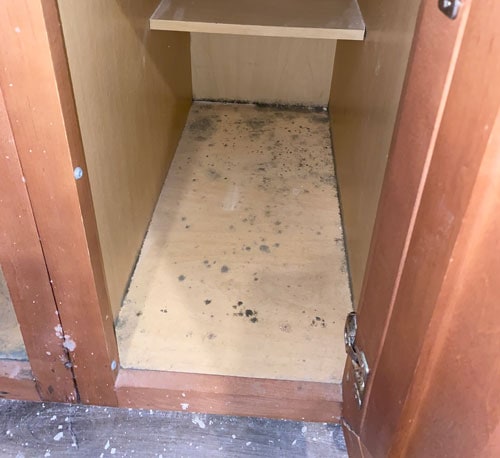Do dehumidifiers kill mold?
Dehumidifiers are a powerful weapon in our battle against mold. However, they are not the magic bullet that some people may think they are – particularly if you already have a mold problem!
While removing mold is a job best left to professionals, dehumidifiers are a great tool for mold prevention. This article will look at how you can use a dehumidifier to help keep your home safe from mold and provide some tips for keeping mold at bay.
What is a dehumidifier?
Dehumidifiers are specialized devices which pull moisture out of the air. While there are some whole-home dehumidifiers on the market, most dehumidifiers are sized to handle a single room.
There are two main types of dehumidifiers, refrigerant and desiccant, and while their mechanism of operation is different they both accomplish the same task.
Refrigerant Dehumidifiers
Refrigerant dehumidifiers operate by blowing air over cold coils, reducing the air’s ability to retain moisture. Excess moisture then condenses onto the coils and drips into a water tank.
The principle is very similar to how air conditioning units work – except that since the hot side and the cool side of the unit are put together the net effect on your room’s temperature is negligible. This allows dehumidifiers to run for long periods of time, pulling more moisture out of the air than a standard HVAC can.
Unlike air conditioners, which use thermostats to regulate their operation, dehumidifiers use hygrometers – a device which measures relative humidity.
Desiccant Dehumidifiers
Unlike refrigerant dehumidifiers which rely on temperature changes to extract moisture from the air, desiccant dehumidifiers capture moisture with a hygroscopic material like silica gel. The moisture content is then released from the desiccant media by heating it and channeling the runoff into a drain pan.
Desiccant dehumidifiers can reach much lower levels of relative humidity and operate in colder environments than refrigerant dehumidifiers – although for household use these benefits may not prove significant.
One benefit that everyone can appreciate is that desiccant dehumidifiers are usually quieter than their compressor-driven counterparts. This can make them more welcome additions to bedrooms or offices where the hum of refrigeration compressors can grow tiresome.
How does mold grow?
Molds are a type of fungus and are found everywhere on earth, including Antarctica! There are literally thousands of species of molds, and hundreds are happy to take up residence in your home.
Molds reproduce by creating microscopic spores, which due to their tiny size are easily sent airborne by the tiniest of breezes. These spores settle on everything – virtually every surface outside of an industrial clean-room is contaminated with spores from dozens of species. A study in California found that even in the cleanest homes researchers could detect 36 mold spores per cubic meter of air, while some homes were found to have nearly 6,000 spores per cubic meter!
How do dehumidifiers prevent mold growth?
Despite the sheer number of mold species out there – they generally share a preference for humid conditions. When indoor humidity rises above 60% mold spores begin to germinate and can quickly turn into a full blown infestation.
Dehumidifiers keep mold and mildew in check by preventing them from having the right conditions to grow in the first place. Just like we use cold temperatures in our refrigerators to keep spoilage bacteria from growing, we can use dehumidifiers to create conditions which are too dry for mold growth.
Will a dehumidifier kill my existing mold?
No. If you currently have a mold problem a dehumidifier will not be able to eliminate it. Dehumidifiers help prevent molds from spreading further, but will not eliminate the musty smell or health problems associated with mold, nor will the mold colonies die out.
Many common indoor molds, like black mold, create a slime layer that helps them retain moisture. Once the spores have developed into a colony you will need a more extensive mold remediation plan. Usually you will need to use a chemical based cleaner, like bleach, along with a good amount of elbow grease! Some materials, like drywall, will need to be replaced as mold infestations will not be able to be removed.
Are there any other benefits of a dehumidifier?
Yes, dehumidifiers help prevent mold and mildew, but also offer additional benefits.
High humidity levels have a way of making both hot and cold temperatures less pleasant. In the summers, high indoor humidity means that sweat doesn’t evaporate as readily, making you feel hot and sticky. Conversely, in the winter, high indoor humidity can make the air feel clammy and cold.
Mold is not the only thing that appreciates high humidity – dust mites and other critters like cockroaches also prefer higher moisture levels. These household pests are common sources of allergens and can exacerbate asthma in sensitive individuals, so it is essential to manage humidity in order to maintain good indoor air quality and avoid health issues.
The EPA recommends that you keep indoor humidity between 30 and 50%, both for safety and comfort.
How will you know if a dehumidifier is helping with mold?
The easiest way to tell if your dehumidifier is helping prevent mold growth, is to monitor the relative humidity (RH) in the room. The best dehumidifiers have built-in hygrometers which lets you see the humidity level of your room at a glance, while some budget models may not provide you with this information. Hygrometers are readily available at home improvement stores and from online retailers like Amazon.
As long as the RH is below 50% you do not have to worry about mold growth.
Keep in mind that most dehumidifiers are not powerful enough to dehumidify your whole house. Rooms with poor air flow and high humidity may require more powerful dehumidifiers in order to reach the desired RH.
If your dehumidifiers are struggling to lower the humidity to safe levels, then you may need to address the source of moisture itself. Even small plumbing leaks can generate a great enough amount of moisture to overwhelm a typical dehumidifier.
Prevention, But Not a Cure
Maintaining a healthy indoor humidity level is essential for preventing mold and mildew, and dehumidifiers are homeowners best tool in the fight against humidity.
However, it is important to realize that if you have already experienced water damage or have mold build-up, a dehumidifier will not be sufficient on its own. In order to prevent musty odors, and potential respiratory problems, you will need to perform mold remediation yourself, or work with a professional mold removal company.



